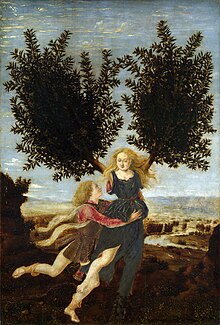| Revision as of 03:13, 6 February 2014 edit107.212.65.142 (talk) Undid revision 594101649 by 74.178.213.237 (talk) Anachronistic use of "soccer and golf" in article.← Previous edit | Revision as of 18:26, 9 February 2014 edit undo24.154.174.37 (talk) →The mythNext edit → | ||
| Line 4: | Line 4: | ||
| '''Apollo and Daphne''' is a story from ancient ], retold by ] and ] authors in the form of an amorous ]. | '''Apollo and Daphne''' is a story from ancient ], retold by ] and ] authors in the form of an amorous ]. | ||
| ==The |
==The thing== | ||
| The curse of ], the god of the sun and music, was brought onto him when he insulted the young ] for playing with bow and arrows. | The curse of ], the god of the sun and music, was brought onto him when he insulted the young ] for playing with bow and arrows. | ||
Revision as of 18:26, 9 February 2014
For the Handel cantata, see Apollo e Dafne (Handel). For the Bernini sculpture, see Apollo and Daphne (Bernini).
Apollo and Daphne is a story from ancient Greek mythology, retold by Hellenistic and Roman authors in the form of an amorous vignette.
The thing
The curse of Apollo, the god of the sun and music, was brought onto him when he insulted the young Eros for playing with bow and arrows.
Apollo was a great warrior and said to him, "What have you to do with warlike weapons? Leave them for hands worthy of them. Behold the conquest I have won by means of them over the vast serpent who stretched his poisonous body over acres of the plain! Be content with your torch, child, and kindle up your flames, as you call them, where you will, but presume not to meddle with my weapons."
The insulted Eros took two arrows, one of gold and one of lead. With the leaden shaft, to incite hatred, he shot the nymph Daphne and with the golden one, to incite love, he shot Apollo through the heart. Apollo was seized with love for the maiden, Daphne, and she in turn abhorred him. In fact, she spurned her many potential lovers, preferring instead woodland sports and exploring the woods. Her father, Peneus, demanded that she get married so that she may give him grandchildren. However, she begged her father to let her remain unmarried.
Apollo continually followed her, begging her to stay, but the nymph continued her flight. They were evenly matched in the race until Eros intervened and helped Apollo gain upon Daphne.
Seeing that Apollo was bound to catch her, she called upon her father, "Help me, Peneus! Open the earth to enclose me, or change my form, which has brought me into this danger!"
Suddenly, her skin turned into bark, her hair became leaves, and her arms were transformed into branches. She stopped running as her feet became rooted to the ground. Apollo embraced the branches, but even the branches shrank away from him. Since Apollo could no longer take her as his wife, he vowed to tend her as his tree, and promised that her leaves would decorate the heads of leaders as crowns, and that her leaves were also to be depicted on weapons. Apollo also used his powers of eternal youth and immortality to render her ever green. Since then, the leaves of the Bay laurel tree have never known decay.
Apollo and Daphne in art

Between 1622 and 1625, Gian Lorenzo Bernini sculpted a Baroque, life-sized marble entitled Apollo and Daphne. Apollo clutches Daphne’s hip pursuing her as she flees trying to escape him. Apollo desperate and longing wears a laurel crown foreshadowing Daphne’s metamorphosis into the laurel tree. Daphne is portrayed halfway through her metamorphosis into the laurel tree with her arms already transforming into its branches as she flees and calls to her Father to save her from Apollo.
Artists such as Antonio and Piero del Pollaiolo often manipulated scenes from famous Greek mythology into the setting of their time periods. In Pollaiolo's painting Apollo and Daphne, both Apollo and Daphne are shown dressed in Renaissance garments as Daphne is in the midst of transforming into the laurel tree. It hangs today in the National Gallery in London.
Charles Garabedian displays Apollo and Daphne quite differently than the usual rendering.
In recent literature it has been argued that "The Kiss" of Gustav Klimt is a painting symbolic of the kissing of Daphne by Apollo at the moment she is transformed into a laurel tree.
Chastity vs. lust
The myth of Apollo and Daphne has been examined as a battle between chastity (Daphne) and sexual desires (Apollo). As Apollo lustfully pursues Daphne, she is saved through her metamorphosis and confinement into the laurel tree which can be seen as an act of eternal chastity. Daphne is forced to sacrifice her body and become the laurel tree as her only form of escape from the pressures of Apollo’s constant sexual desires. Apollo takes Daphne’s eternal chastity and crafts himself a wreath out of her laurel branches turning her symbol of chastity into a cultural symbol for him and other poets and musicians.
Adaptations
Ursula Dubosarsky's play for children, The Boy With the Golden Arrow, first published in the NSW School Magazine, is based on the myth of Daphne and Apollo.Laura Elizabeth Woollett's novel The Wood of Suicides is a modern adaptation of the myth, with the protagonist's first name, Laurel, referring to Daphne.
References
- ^ Impeluso, Lucia (2003). Gods and Heroes in Art. Los Angeles: Getty Publications.
{{cite book}}: Unknown parameter|coauthors=ignored (|author=suggested) (help) - http://www.lalouver.com/resource/charles_garabedian_2010/large/Charles-Garabedian_Apollo-and-Daphne-2009-acrylic-on-paper.jpg
- Vives Chillida, Julio (2008). El beso (los enamorados) de Gustav Klimt. Un ensayo de iconografía. Lulu. ISBN 978-1-4092-0530-2.
- Paulson, Ronald, and Peter Eisenman. Sin and Evil: Moral Values in Literature. Pennsylvania: Yale University Press, 2007. Print.
- http://www.amazon.com/Daphne-Apollo-Children-Metamorphoses-ebook/dp/B00ACY4O1K/ref=sr_1_1?s=digital-text&ie=UTF8&qid=1356852185&sr=1-1&keywords=dubosarsky
- http://www.amazon.com/Wood-Suicides-Laura-Elizabeth-Woollett/dp/1579623506